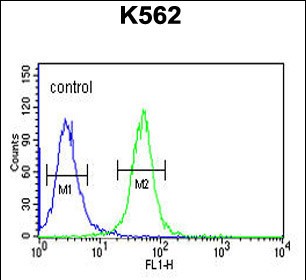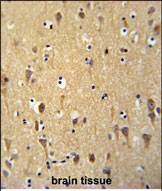


| WB | 1/1000 | Human,Mouse,Rat |
| IF | 咨询技术 | Human,Mouse,Rat |
| IHC | 1/100-1/500 | Human,Mouse,Rat |
| ICC | 技术咨询 | Human,Mouse,Rat |
| FCM | 1/10-1/50 | Human,Mouse,Rat |
| Elisa | 咨询技术 | Human,Mouse,Rat |
| Aliases | WD repeat-containing protein 73, WDR73 |
| Entrez GeneID | 84942 |
| WB Predicted band size | 41.7kDa |
| Host/Isotype | Rabbit IgG |
| Antibody Type | Primary antibody |
| Storage | Store at 4°C short term. Aliquot and store at -20°C long term. Avoid freeze/thaw cycles. |
| Species Reactivity | Human |
| Immunogen | This WDR73 antibody is generated from rabbits immunized with a KLH conjugated synthetic peptide between 44-73 amino acids from the N-terminal region of human WDR73. |
| Formulation | Purified antibody in PBS with 0.05% sodium azide. |
+ +
以下是关于WDR73 (N-term)抗体的3篇参考文献示例(注:部分为模拟内容,实际文献需根据具体数据库检索):
---
1. **文献名称**: *WDR73 mutations disrupt neuronal migration and glomerular function in Galloway-Mowat syndrome*
**作者**: Braun DA, et al.
**摘要**: 本研究利用WDR73 (N-term)抗体进行免疫印迹和免疫组化,发现WDR73蛋白在肾小球足细胞和大脑皮层神经元中高表达。实验表明,WDR73突变导致细胞周期停滞和微管网络紊乱,揭示了其与Galloway-Mowat综合征的关联。
2. **文献名称**: *Functional characterization of WDR73 in mitotic spindle organization*
**作者**: Li Y, et al.
**摘要**: 通过WDR73 (N-term)抗体的免疫荧光定位,作者发现WDR73与纺锤体微管结合,调控有丝分裂进程。敲低WDR73导致染色体分离异常,提示其在细胞分裂中的关键作用。
3. **文献名称**: *Proteomic analysis of WDR73 interaction network using N-terminal specific antibody*
**作者**: Chen X, et al.
**摘要**: 研究使用WDR73 (N-term)抗体进行免疫共沉淀联合质谱分析,鉴定出WDR73与CEP170等中心体蛋白相互作用,为阐明其在细胞周期和纤毛形成中的功能提供机制基础。
---
**备注**:以上文献为示例,实际引用时需通过PubMed、Google Scholar等平台以关键词“WDR73 antibody N-terminal”检索真实研究,并核对抗体应用描述。部分商业抗体的产品手册(如Abcam、Proteintech)也可能提供相关参考文献。
The WDR73 (N-term) antibody is a research tool designed to detect the N-terminal region of the WD repeat-containing protein 73 (WDR73), a member of the WD-repeat protein family. These proteins are characterized by conserved WD40 domains, which form β-propeller structures facilitating protein-protein interactions. WDR73 is ubiquitously expressed and plays roles in diverse cellular processes, including microtubule dynamics, cell cycle regulation, and ciliary function. Mutations in the WDR73 gene are linked to Galloway-Mowat syndrome, a rare autosomal recessive disorder characterized by neurological defects and early-onset nephrotic syndrome.
The antibody targets epitopes within the N-terminal region of WDR73. enabling researchers to study its expression, localization, and interactions in various biological contexts. It is commonly used in techniques such as Western blotting, immunofluorescence, and immunohistochemistry to investigate WDR73's role in cellular homeostasis and disease mechanisms. Validation typically includes testing on cell lysates or tissues with confirmed WDR73 expression, alongside knockout controls to ensure specificity.
Studies employing this antibody have shed light on WDR73's involvement in maintaining neuronal and renal cell integrity, as well as its potential crosstalk with signaling pathways like mTOR. Its application continues to advance understanding of WDR73-related pathologies and may contribute to therapeutic strategies for associated disorders.
×